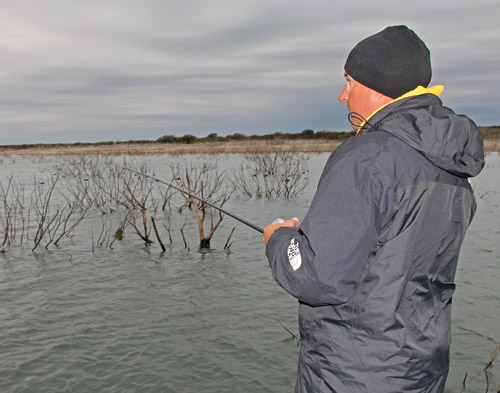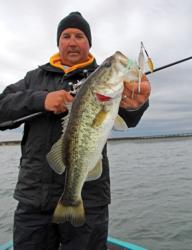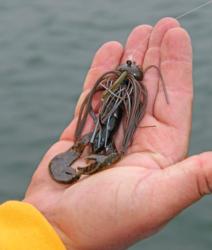Pro Lessons: Prespawn stages
Pro Stephen Johnston reveals that not all bass spawn alike

(Editor’s note: This article originally appeared in the January/February issue of Bass Fishing magazine. To read more compelling articles from Bass Fishing magazine each month, become an FLW subscriber member. If you’d like to sign up for a digital subscription to access articles online, click here).
Angler: Stephen Johnston
Fishery: Lake Amistad
Fishery type: Rio Grande impoundment
Primary forage: shad and bream
Date: Feb. 5, 2012
Wind: 10 to 15 mph
Sky: cloudy, drizzling rain
Water temperature: 50 to 52 degrees
Air temperature: 48 to 50 degrees
Water conditions: about 3 feet low
To some degree, bass fishing always resembles a game of hide-and-seek. However, the fish often hide from environmental conditions as much as they do from anglers.
On a dim morning in early February, pro Stephen Johnston and I set out onto Lake Amistad to see if there was anything the Hemphill, Texas, angler might do to catch a respectable stringer after a sharp cold front sent prespawn fish into a frustrating funk.
Prepping for weather
With Johnston’s father, Wayne, joining us, we launch at the campground ramp off Highway 277 at around 8 a.m. A drizzly rain has just started to dry up about the time the trailer splashes in, but it looks as if we’ll never see the sun this day. A cold, damp weather system pushing across south Texas has brought declining temperatures and increasing winds. Consequently, Stephen decides to tuck into the semi-protected pocket of San Pedro Canyon on the lake’s east end.
Our target is the flooded mesquite in the northernmost of four major creek arms – the spot that a day earlier had produced an FLW College Fishing victory for Stephen’s stepson, Danny Isles, and his partner, Justin Royal, of Lamar University.
The spawn is starting, so backwaters like those of San Pedro’s creeks should be loaded with fish, but the cold front has dropped the water temperature from about 60 to 54 degrees, and the fish seem unresponsive at first. As my guide points out, however, a little faith in the instincts hard-wired into a largemouth’s brain will usually get a fisherman through such difficult days.
“With it falling about five degrees overnight, it kind of gives them a headache; it gets them in a nonchasing mode,” Stephen says. “These fish have just gone down and stuck their heads in the grass. A lot of people think these fish leave [when a cold front comes through], but once they’ve made their move into a spawning area, they’re not going to swim half a mile back out to the deeper water. They’ll just sit here and not bite.”
Feathers and fins
San Pedro Canyon is a bird-watchers paradise – particularly for waterfowl. Without altering our fishing distances or angles, I manage to photograph pintails, wigeons, shovelers, canvasbacks, buffleheads, ruddy ducks, loons and grebes, along with a stadium’s capacity of coots. At first blush, this amazing abundance might be relegated to the ambiance file, but there is a relevant connection to the seasonal pattern we are pursuing.
Stephen explains that prespawn bass used to sit out in the deeper water near the main-lake channel this time of year, but the dense aquatic vegetation that has grown in gives them a two-fold reason to stage farther into their spawning bays: food and cover. With Amistad’s volume recently reduced in order to supply downstream agricultural needs, low water reveals a foot or two of countless mesquite skeletons that were recently submerged, and dangling strands of hydrilla.
“In a lot of areas on this end of the lake, the hydrilla has grown in the backs of these pockets,” Stephen says. “It’s really changed things for me in the last 10 years. Those fish used to sit out in that 25- to 35-foot zone and wait for the right weather to move up. Now, the hydrilla provides a home for those fish to live in while they’re waiting to move up.
“With that cold front we had come through last night, they have enough area where they can sit in the grass and stay warm and still have food,” he continues. “They didn’t have to turn around and swim back out to the deeper water.”
Yes, you wood
Meandering through the spindly branches, Stephen’s course appears random, but such is not the case. With alternating looks at his depth finder, Stephen stays close to the creek channel’s strongest contour features as we fish our way through the creek.
“When a creek makes a bend to the left or a bend to the right, that’s an intersection for those fish,” he says. “Those fish swim in so far, and they’ll get in a bend and sit there. I can look at the mapping area of my fish finder and see where those bends are located. I have a couple of waypoints on bends where I’ve had bites.”
Beyond the electronics, Stephen notes a surface-level indicator that stands as clear as a road sign: flooded trees.
“The hardwoods will be on the inside bend of where the creek was,” he says. “A lot of people just come in, put the trolling motor down and start fishing without taking just a few minutes to look around and see what they’re looking at.
“For example, right in front of us it’s 2 feet, and we’re sitting in 6 feet,” he continues. “With this cold front, these fish are not going to be in that 2-foot section. They’re going to slide back into the deeper water and just sit there. You can look for the hardwoods and look for the gaps between the mesquite trees going through here – that’s where the creek makes the swing.”
Patient pace
 Stephen follows the 4- to 6-foot depths of the northern creek arm’s lower half. Here, he probes the branches with a Strike King Red Eye Shad (green back, clear belly) lipless crankbait, a perch-colored V&M swim jig with a V&M Hightail Shad trailer, a Cyclone spinnerbait and a Texas-rigged green pumpkin V&M 6-inch Lizard.
Stephen follows the 4- to 6-foot depths of the northern creek arm’s lower half. Here, he probes the branches with a Strike King Red Eye Shad (green back, clear belly) lipless crankbait, a perch-colored V&M swim jig with a V&M Hightail Shad trailer, a Cyclone spinnerbait and a Texas-rigged green pumpkin V&M 6-inch Lizard.
“The biggest thing for me is to just slow down,” Stephen says. “The key is having a shallow-water anchor. You can position yourself a lot better with two. Like today, this wind is blowing about 18 to 20 mph, and if I’m sitting on the edge of the creek channel, I can anchor myself where I have the exact cast where I don’t have a bow in my line and can keep a lot better contact with the bait.”
The ability to make incremental moves and tightly control boat positioning proves critical to his strategy of tracing the creek channel and focusing on those all-important bends.
Stephen eases up to the next bend and anchors the pair of Minn Kota Talons in place. First, he makes a few casts with the spinnerbait, then picks up the lizard and makes several more casts at different angles.
“You have to make yourself sit where those fish are and keep throwing at them,” he explains. “They’re down there looking at the bait, and sooner or later, you’re going to get one to react. Once you get one to react, you’ll get them in a little feeding frenzy and you can catch them.”
Slipping out
Although the shallower water near the creek proves too cold for the fish, Stephen finds his flurry of activity when he moves out a little deeper to the 12- to 15-foot depths. Around 9 a.m., a 2-pounder grabs his spinnerbait, and between 10 and 10:15 he catches a trio of keepers on a Megabass Vision 110 jerkbait in the Table Rock shad color pattern. The fish were suspending around scattered hydrilla, and a slow retrieve with lengthy pauses gave them enough time to ease in for a bite.
The bass was about 10 feet deep, staging in and around the scattered trees and grass before moving into the creek.
“A lot of times, these fish out a little deeper are eating, and they’re a little bit easier to catch,” explains Stephen. “The only problem is that they’re roamers – there’s no creek out here for them to gather around.”
Stephen takes a moment to show off the spinnerbait he’s using. The area where he finally found some fish is very clear, but its visibility is somewhat muted by the overcast conditions. He says that such days compel him to alter his standard clear-lake spinnerbait setup – double silver willow blades – to a No. 3 gold willow on the inside and a No. 5 silver on the outside for a little more flash.
A look at later fish
 When the jerkbait bite fizzles, Stephen moves west of the 277 Bridge and fishes rocky points that stair-step over a range of about 10 to 35 feet before plunging into more than 50 feet off the adjacent channel. Wayne starts with a Carolina-rigged green pumpkin lizard, while his son works a 3/4-ounce V&M football jig with a green pumpkin Strike King Rage Tail Rage Craw trailer over the rocky bottom. The Carolina rig fails to impress, so Wayne converts to a matching football-head jig after his son boats a keeper.
When the jerkbait bite fizzles, Stephen moves west of the 277 Bridge and fishes rocky points that stair-step over a range of about 10 to 35 feet before plunging into more than 50 feet off the adjacent channel. Wayne starts with a Carolina-rigged green pumpkin lizard, while his son works a 3/4-ounce V&M football jig with a green pumpkin Strike King Rage Tail Rage Craw trailer over the rocky bottom. The Carolina rig fails to impress, so Wayne converts to a matching football-head jig after his son boats a keeper.
Three more fish, including a 3- and a 4-pounder, swing over the front of the boat.
“This is just another group of fish that will probably be here until April before they make the move,” Stephen says. “There’s a lot of 100-foot water nearby, and a lot of these fish don’t live on the bank. A lot of them are suspended in the river.”
He explains that there are several stages of fish in the lake at most times near the spawn. Where we started, the fish are already in their spawning area. The bass we found after we moved out a little deeper are part of another wave of fish working their way back in. The fish caught west of the bridge are nowhere near ready to move up.
The rain returns after the 4-pounder is released and we decide it’s time for us to leave. By this point, San Pedro Canyon has provided some clear perspective. Not all the bass are using the same playbook. As Stephen notes, most anglers can easily define the general shoreward movement of prespawn bass, but understanding how various groups of bass in various stages react to bad weather is the tricky part.
“Many people think there’s just one stage of fish, but there are many stages of fish,” Stephen says. “The key is knowing where to find each one.”
Lessons learned
• Creek-channel bends are natural gathering points for bass.
• Hardwood trees and open lanes within flooded mesquite indicate the deeper channel bends.
• On cloudy days, switching from double willow-leaf blades to one gold and one silver increases flash and visibility.
• Spawning might occur in waves that are several weeks apart, so if one group of fish is uncooperative, just move incrementally deep